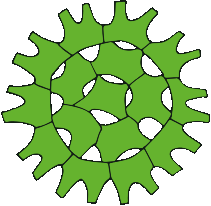What a nice site!Information about - yes - Fauna Europaea. Works fast, quite clear to my opinion, nice taxonomic trees and maps - and a bunch of links to other on-line databases. I was looking for a link to the Dutch taxa-database, the TWN-list, but it isn't there. Perhaps because it's in Dutch. At least what the phytoplankton concerns, it's quite wondeful. When do they go international?
Read More
Author: Satu Zwerver
Angry birds in a puddle
While cycling to an apple-blossom picnic, I stopped at a little puddle that looked very promising. Nice dark, water with pH around 5. I thought there might be some beautiful Desmids waiting for me. I filled the bottle, enjoyed the picnic under the blossoming apple trees with friends, good food and Irish songs - and waited anxiously till the next day, when I was ble to take a look at my sample. And this is what I saw: Don't they look like the famous Angry birds? I have never played the game, but I still haven't managed to walk through my life without paying any attention to them. Th...
Read More
The slender Planktothrix -species
Tricky, these slender Planktothrix -species. But if they really are only 3 µm wide, have no particular features in end cells, no calyptra like Pl. prolifica, nor those characteristically elongated aerotopes like Pl. suspensa - then we are just stuck with the good old Plantktothrix agardhii. Sensu lato that is. In lugol preserved samples the red color - which would reveal the true nature of Pl. profilica - can not either be observed. So, to be on the safe side it's better to call it Planktothrix cf. agardhii.Literature:KOMÁREK J. & ANAGNOSTIDIS K. (2005): Cyanoprokaryota 2. Te...
Read More
Pseudotetraëdriella kamillae
It is there. In different Finnish waters, this tiny little thing. Hegewald, Padisák, and Friedl (2007) found that this little thing differed markedly from other look-a-like algae and give a firm description of the differences in their article. A new family - Loboceae E. Hegewald - and a new genus - Pseudoteraëdriella Hegewald - was established in the Class Eustigmatophyceae Hibberd - and look: Pseudotetraëdriella kamillae Hegewald & Padisák had found it's place in the taxonomic tree. One might easily overlook it. Or mix it with Tetraëdron minimum or Tetraëdriella jovetii, but it is different....
Read More
Co-operation rules!
Wonderful! A combination of passions: Adventurers and Scientists for Conservation.
Read More
Fighting algae with algae
An Indian company NUALGI NANOBIOTECH makes the product "Nualgi" to solve a wide range of problems: * to boost the growth of prawns and fishes in aquaculture ponds * to treat sewagewater, polluted and effluent waters and to reduce COD, BOD, color and bad odour in them* to prevent growth of toxic algal species called 'red tides' in the seaand even * to absorb global carbon dioxide and reduce greenhouse gases thereby solving global warming problem.All this is done by our little friends, the algae. In this case specifically the diatom algae. The idea is to stimulate the growth of the diatoms, ...
Read More
ANSP / NAWQA / EPA 2011 Diatom and Non-Diatom Taxa
This week there was a message from both DIATOM-L and ALGAE-L about a set of taxa names they have been developing in USA: http://diatom.ansp.org/nawqa/Taxalist.aspx.Makes me wonder about the cleverness in making all kinds of - more or less taxonomically correct - algae lists in different countries. When does the dawn of international algae lists break through? Nordic Microalage has made a nice start. But a larger European co-operation on this subject would not be harmful. Not to talk bout the rest of the world. Step by step... Do take a look at the rest of the pages of the Phycology Section, Pa...
Read More
A cordial blue-green algae
They really are heart shaped, the cells of of the blue-green algae Gomphosphaeria: Although it's not as nicely visible here as in Joostens (2006) book, see page 153. This is the type species Gomphosphaeria aponina, because it has a thin, yet very clear layer enveloping the individual cells: There used to be a lot of different Gomphosphaeria-species, but then - in 1980's - misters Komárek and Hindák took a closer look at these species and divided three genera out of this group: Gomphosphaeria Kützing 1836, Woronichinia Elenkin 1933 and Snowella Elenkin 1938. They al...
Read More
Brown beans
I saw these brown beans hanging on a Tabellaria today:
and was wondering, what was this again..? Being sure I had seen a picture like this somewhere I tried to recall in which book. Was it in the Yellow-green algae (Xanthophyceae) book? Or was it in the Green algae book (Chlorophyceae, Chlorococcales) from Komárek the Great and Fott the Fine? Or perhaps in the Dinophyceae book??There is something that makes one think about the Xanthophyceae: the thick, transparent walls and even some red oil dops. But the color is very dark... and it looked like they did not put m...
Read More
Coastal Phytoplankton – a book
The Photo Guide for Northern European Seas, Coastal Phytoplankton book from Alexandra Kraberg, Marcus Baumann and Claus-Dieter Dürselen is worth taking a look in.The size is handy, the photo's are fine, the quality of paper very good. It has nice, clear drawings to clarify the different structures in plankton organisms. Every species has one whole page for itself, with mostly good photos and drawings. Furthermore on top of every page you can find a bulk of information of the species in a very concentrated, yet not in a cluttered manner. Very handy are the tips about the similar species. When ...
Read More
